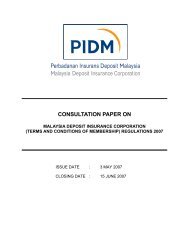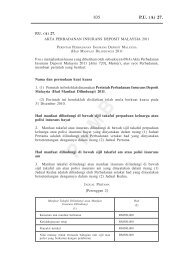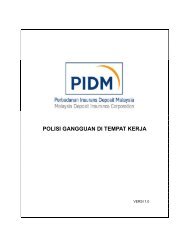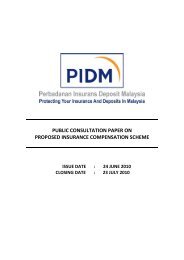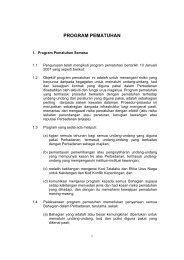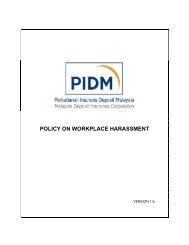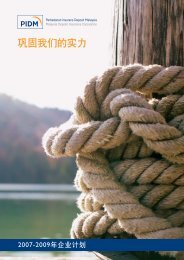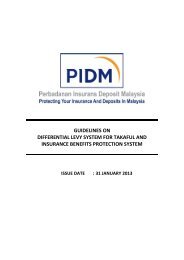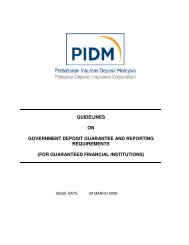Enhancing Financial Consumer Protection ANNUAL ... - PIDM
Enhancing Financial Consumer Protection ANNUAL ... - PIDM
Enhancing Financial Consumer Protection ANNUAL ... - PIDM
- No tags were found...
You also want an ePaper? Increase the reach of your titles
YUMPU automatically turns print PDFs into web optimized ePapers that Google loves.
Section 1INTRODUCTION
<strong>PIDM</strong> reports to Parliament through the Minister of Financeand is currently governed by a nine-member Boardof Directors. We are also known internationally as theMalaysia Deposit Insurance Corporation.ENHANCED FINANCIAL CONSUMER PROTECTIONUnder the new MDIC Act 2011, financial consumerprotection in Malaysia has been enhanced. Effective31 December 2010, the limit for deposit insurance wasincreased to RM250,000 from RM60,000 while the scopeof coverage was extended to foreign currency deposits.The implementation of the Provision of Information onDeposit Insurance Regulations in April 2011 has furtherstrengthened knowledge of the DIS. These Regulations areto ensure member banks provide depositors with accurate,relevant and timely information on deposit protection andcoverage for deposit products they offer.The new MDIC Act has entrusted <strong>PIDM</strong> with the addedresponsibility of administering TIPS to provide protection toowners of takaful certificates and insurance policies.In the event of a troubled member institution, <strong>PIDM</strong> willact promptly to protect owners of takaful certificates orinsurance policies whatever the case may be and takeappropriate measures to promote and maintain publicconfidence in the stability of the Malaysian financial system.FINANCIAL SYSTEM STABILITYIn carrying out our functions, we work closely with BankNegara Malaysia (BNM), the primary regulator andsupervisor. Our working relationship is mandated in theMDIC Act and detailed in a Strategic Alliance Agreement.Our partnership with BNM is critical, and ensures timelyexchange of information on financial institutions andcollaboration in all significant aspects of our risk assessmentand monitoring activities as well as intervention and failureresolution activities.<strong>PIDM</strong> also complements the existing regulatory andsupervisory framework by providing incentives formember institutions to implement sound risk managementpractices. We are also empowered to intervene early toreduce or avert losses to the financial system, and we haveat our disposal a wide range of legislative tools to deal withdistressed member institutions.<strong>PIDM</strong> undertakes risk assessment and monitoring of allmember institutions and works closely with the supervisoryauthority to ensure that our concerns about the businessand affairs of member institutions are addressed promptly.However, we necessarily rely on the supervisory authorityto take prompt corrective action to mitigate the possibilityof a member institution failure. Our intervention andresolution powers enable us, among others, to undertakedue diligence or special examinations of troubledmembers. Once a member institution is deemed by thesupervisor to be no longer viable, we can intervene and ifnecessary assume control over the institution or take suchother resolution action that minimises costs to the financialsystem.Timely and clear communications to engender publicconfidence in the DIS and TIPS are key to our success inpromoting and contributing to the stability of the financialsystem. As such, we carry out a multi-year public awarenessprogramme and education initiatives to enhance the levelof awareness and understanding about the benefits andlimitations of our financial consumer protection.P I D M A n n u a l R e p o r t 2 0 1 15
INTRODUCTIONTHE YEAR AT A GLANCESince its inception in 2005, <strong>PIDM</strong> has established and maintained a strong governance framework, a sound system ofinternal controls as well as effective business practices and processes. For 2011, we continued to focus our key efforts onsupporting the state of readiness of the Corporation in the following key areas:• building our capacity and capability in terms of operational readiness as well as intensifying risk assessment andmonitoring activities;• promoting public awareness including enhancing education initiatives;• improving our operational effectiveness and efficiency; and• enhancing the infrastructure, systems, policies and practices to effectively administer TIPS.The new MDIC Act 2011, which came into operation on 31 December 2010, entrusted the Corporation with an enhancedmandate, greater powers and responsibilities, so as to continue to promote and contribute to public confidence in thestability of the financial system. In 2011, we completed a substantial number of initiatives relating to TIPS, and our publicawareness campaign was expanded to include initiatives on educating insurance policy and takaful certificate owners.We completed the majority of our planned key initiatives, with the exception of six information technology-related initiativeswhich have been reprioritised. These initiatives were achieved under budget, as set out in our approved financial plan.6P I D M A n n u a l R e p o r t 2 0 1 1
HIGHLIGHTS OF OUR ACCOMPLISHMENTS IN 2011Stakeholders• Implemented the enhanced “<strong>PIDM</strong> Project MoneySmart 2011”, the education programme for secondary schoolsand tertiary students. We also included TIPS-related questions in the MoneySmart Online Game.• Implemented the Provision of Information on Deposit Insurance Regulations.• Continued to maintain good relationships with other deposit insurers and central banks around the world throughparticipation in the International Association of Deposit Insurers (IADI) and by hosting study visits.• Executed a Memorandum of Understanding with the Central Deposit Insurance Corporation, Taiwan to promotecooperation and collaboration through sharing and transfer of knowledge.Governance and Internal Processes• Held several Board education sessions in various areas such as risk assessment and monitoring, target fund,Intervention and Failure Resolution (IFR) as well as TIPS.• Continued to implement the succession plan for Directors and Management.• Continued our work on Corporate Social Responsibility including by implementing our multi-year ScholarshipProgramme, and by sponsoring money management and career planning workshops for the hearing-impairedcommunity.• Completed the remaining ERM Board Risk Policies on Reputation Risk, Assessment and Monitoring Risk,Strategic and Governance Risk, Operational Risk as well as Intervention and Failure Resolution (IFR) Risk.• Continued to support the <strong>Financial</strong> Institutions Directors’ Education (FIDE) Programme and its Alumni associations(FIDE Forum).• Issued guidelines to insurer members and enhanced guidelines applicable to member banks.• Developed the comprehensive Risk Assessment Methodology and Framework as well as the Supervisor Validationfor the Returns on Calculation of Premiums for TIPS.• Conducted training sessions on IFR for all employees, as well as two mini simulations and one two-and-a-half-daysimulation exercise.• Completed the integration between the Payout system modules, and the development of the audit programmefor Depositor Liabilities Information Management System (DLIMS) to ensure the integrity of payout data.• Developed the Authority Matrix, which summarises the authorities for the day-to-day administration of thebusiness and affairs of the Corporation.• Completed the development of the interim Disaster Recovery Site (DRS) and tested the Business Continuity Plan.Learning and Growth• Continued to develop our employee talents through a comprehensive Learning and Development plan.• Developed the Knowledge Management framework in support of continuous knowledge sharing among theemployees.• Continued to implement the competency model and succession planning based on the Board-approvedframework for key positions.• Conducted the employee satisfaction survey.External Recognition• Received the “2011 Deposit Insurance Organisation of the Year” Award, presented by the IADI.• Received the “Best Annual Report of Non-Listed Organisations” Award for our 2010 Annual Report, awarded atthe National Annual Corporate Report Awards (NACRA).P I D M A n n u a l R e p o r t 2 0 1 17
Awards and RecognitionGuided by the mission and vision, <strong>PIDM</strong> has made significant inroads since its inception in 2005. Withgreat teamwork and a culture of excellence, the Corporation has risen to greater heights towards beingrecognised as a best practice financial consumer protection organisation.NACRA 2011 Best AnnualReport of Non-ListedOrganisations<strong>PIDM</strong> has been awarded the “Best AnnualReport of Non-Listed Organisations” bythe National Annual Corporate ReportAwards (NACRA) for the third consecutiveyear. This award is in recognition ofachieving NACRA’s benchmark of highgovernance standards, excellence incorporate reporting in terms of highstandards of transparency and disclosureof information as well as greater corporateaccountability.Winning this prestigious accolade for threeconsecutive years is a further testimonyof our continuous effort to enhance ourquality of disclosure and reporting.IADI 2011 DepositInsurance Organisation(DIO) of the Year Award<strong>PIDM</strong>’s continued efforts for improvementand adoption of best practiceshave produced results and earnedthe Corporation this award by theInternational Association of DepositInsurers (IADI), which is in recognition ofits accomplishments and contributions inthe field of deposit insurance, both locallyand internationally.In his speech at the award presentation,the President of IADI, Martin Gruenberg,said:“<strong>PIDM</strong> was selected to receive theDIO of the year award because of itsachievements in strengthening thedeposit insurance systems and theirassociated contributions to financialstability in Malaysia. It was recognised forits willingness to share its knowledge andto assist in training other IADI members,and through all of its efforts in helping toachieve IADI objectives”.Quality AssuranceReview Certification byThe Institute of InternalAuditors Malaysia<strong>PIDM</strong> has been certified by the Instituteof Internal Auditors Malaysia (IIAM)in recognition of conformity with theInstitute of Internal Auditors’ InternationalStandards for the Professional Practiceof Internal Auditing. This certificationacknowledges that the internal auditfunction of <strong>PIDM</strong> maintains quality workperformance and uses successful auditingpractices, demonstrates professionalismas well as conforms to the internationalstandards.8P I D M A n n u a l R e p o r t 2 0 1 1
INTRODUCTIONFINANCIAL SUMMARY: FIVE-YEAR PERFORMANCE250.0200.0PREMIUM REVENUE201.225.020.0INVESTMENT INCOME21.8SELECTED ITEMS FROM THESTATEMENT OF COMPREHENSIVE INCOMEFOR THE YEARS ENDED 31 DECEMBER2011 2010 2009 2008 2007RM MillionPremium Revenues 201.2 105.7 131.8 90.0 110.1Deposit Insurance Funds 120.5 105.7 131.8 90.0 110.1Takaful and Insurance Benefits <strong>Protection</strong> Funds 80.7 - - - -RM Million150.0100.050.0110.190.0131.8105.7RM Million15.010.05.05.88.57.69.3Investment Income 21.8 9.3 7.6 8.5 5.8Deposit Insurance Funds 12.9 9.3 7.6 8.5 5.8Takaful and Insurance Benefits <strong>Protection</strong> Funds 8.9 - - - -RM Million0.080.060.040.020.02007 2008 2009 2010 2011OPERATING EXPENDITURES69.654.244.934.527.1RM Million0.01,200.01,000.0800.0600.0400.0200.02007 2008 2009 2010 2011NET SURPLUS1,079.588.8 64.094.560.8Gains / (losses) from sales ofavailable-for-sale investments 3.7 - - - -Deposit Insurance Funds - - - - -Takaful and Insurance Benefits <strong>Protection</strong> Funds 3.7 - - - -Operating Expenses 69.6 54.2 44.9 34.5 27.1Operational Net Surplus 157.1 60.8 94.5 64.0 88.8Moneys and investments received fromInsurance Guarantee Scheme Funds 922.4 - - - -Net Surplus for the Year 1,079.5 60.8 94.5 64.0 88.80.020072008 2009 2010 20110.020072008 2009 2010 2011Net unrealised gains / (losses) onavailable-for-sale investments (0.6) - - - -RM MillionRM Million15,000.010,000.05,000.00.0500.0400.0300.0200.0100.00.0CAPITAL EXPENDITURES CONTRACTED7,243200720.9 32.320076,8848,93113,5151,9942008 2009 2010 2011DEPOSIT INSURANCE FUNDS49.056.1 68.5Islamic Deposit Insurance243.0190.4374.6320.9Conventional DepositInsurance2008 2009 2010 2011450.0RM MillionRM Million1,600.01,400.01,200.01,000.0800.0600.0400.0200.00.01,000.0800.0600.0400.0200.00.0215.12007276.84.4 36.7TOTAL ASSETS375.9438.01,518.12008 2009 2010 2011TAKAFUL AND INSURANCE BENEFITSPROTECTION FUNDS – 2011FamilySolidarityTakafulLifeInsurance2.1GeneralTakaful948.0GeneralInsuranceTotal Comprehensive Income 1,078.9 60.8 94.5 64.0 88.8SELECTED ITEMS FROM THESTATEMENT OF FINANCIAL POSITIONAS AT 31 DECEMBERTotal Assets 1,518.1 438.0 375.9 276.8 215.1Total Liabilities 8.4 7.3 6.0 1.5 3.8Funds and Reserves 1,509.7 430.7 369.9 275.3 211.3Deposit Insurance Funds 518.5 430.7 369.9 275.3 211.3Conventional Deposit Insurance Fund 450.0 374.6 320.9 243.0 190.4Islamic Deposit Insurance Fund 68.5 56.1 49.0 32.3 20.9Takaful and Insurance Benefits <strong>Protection</strong> Funds 991.2 - - - -Family Solidarity Takaful <strong>Protection</strong> Fund 4.4 - - - -Life Insurance <strong>Protection</strong> Fund 36.7 - - - -General Takaful <strong>Protection</strong> Fund 2.1 - - - -General Insurance <strong>Protection</strong> Fund 948.0 - - - -Total Liabilities, Funds and Reserves 1,518.1 438.0 375.9 276.8 215.110P I D M A n n u a l R e p o r t 2 0 1 1
12P I D M A n n u a l R e p o r t 2 0 1 1
INTRODUCTIONMESSAGE FROM THE CHAIRMANInsofar as our readiness to conduct an intervention andresolution (IFR) of member banks is concerned, I am pleasedto report that we have completed a set of guidance, so thatall who are involved are clear at the outset on their rolesand responsibilities and what is expected. We have alsoconducted simulations of various IFR scenarios. In a crisis,it is critical to be clear on the authorities of Managementand the Board as well as the accountabilities among safetynet players, and we have established clarity in this regardby developing a comprehensive authority matrix.Takaful and Insurance Benefits <strong>Protection</strong> SystemThe introduction of the Takaful and Insurance Benefits<strong>Protection</strong> System (TIPS) in 2011 was widely welcomedby the public, as we exited the Government DepositGuarantee at the end of 2010. This initiative was in line withdevelopments in the region, such as Singapore, and morelately, Hong Kong. It aims to provide policy owners withprotection, along the lines provided to depositors, therebyproviding a level playing field and enhance the insuranceindustry’s stability and competitiveness. In 2011 we thuswelcomed new member institutions from the insuranceand takaful industry. The Insurance Guarantee SchemeFunds, formerly administered by Bank Negara Malaysia,have been entrusted to <strong>PIDM</strong>, as required by law, and willbe administered separately according to businesses.Our expanded mandate gave rise to many challenges, interms of resources, capability and urgency. In 2011, theBoard made it a priority to deal with these challenges,leveraging on our existing infrastructure through upgrades,improvements and where needed, new initiatives. Inparticular, we focused our public awareness campaign onTIPS, and we are pleased with our survey results that showa fair awareness about TIPS. Key among our priorities wasto also educate our employees on the ins and outs of theindustry. Given our expanded role, we also embarked ondeveloping a comprehensive risk assessment methodologyand framework for insurer members within TIPS, and wehave set specific initiatives for 2012 such as developing adifferential levy system for insurer members.Corporate Governance DevelopmentsThe Board itself continued to focus on aspects ofgovernance needed to ensure continued effectiveness.Board succession planning and identifying the rightcandidates for the Board vacancies was an importantactivity in 2011, and we were gratified with the results.Mr. Alex Foong was appointed with effect from August2011, and Datuk Dr. Rahamat Bivi Yusoff and EncikMohamad Abdul Halim Ahmad were appointed with effectfrom January 2012. The Board also resolved that Boardsuccession planning would be an ongoing long-termactivity for the Board.I am also highly pleased to report on our ongoing effortsto promote corporate governance more widely in theindustry. The <strong>Financial</strong> Institutions Directors’ EducationProgramme, sponsored by Bank Negara Malaysia and<strong>PIDM</strong> since 2008, continues to be a great success. Notonly that, it has inspired former participants to establishan alumni association, with the Governor of Bank NegaraMalaysia as its patron. The Alumni, known as FIDE Forum,and which I currently chair, plans to lead and promotehigh standards of corporate governance among financialinstitutions in Malaysia. Among others, it will arrangeevents for director-networking and life-time learning andwill act as a liaison between industry and regulators. Wetrust that our financial institutions will participate in thisinitiative, which benefits not only them individually, but ourfinancial system as a whole. This is consistent with <strong>PIDM</strong>’sstatutory object of promoting sound risk management inthe financial system.A Note of ThanksBefore I conclude, and on behalf of our Board, I will take thisopportunity to thank Tan Sri Dato’ Abdul Aziz Haji Taha, ourfirst Chairman, for his stalwart leadership and commitment.His unyielding focus on ensuring the implementation ofsound governance and internal controls, excellence andethical behaviour, has set the tone for all of our futureendeavours, and after six years under his guidance, theCorporation stands on solid foundations. On behalf of usall, I would record our deep gratitude to him.I am also grateful for the immense support and wisecounsel of my fellow members of the Board, andthe continuing support of our ex officio Directors,Tan Sri Dato’ Sri Dr. Zeti Akhtar Aziz, the Governor of BNMand Tan Sri Dato’ Sri Dr. Wan Abdul Aziz Wan Abdullah, theSecretary General of the Treasury.As I mentioned earlier, we are fortunate to welcomeMr. Alex Foong as a Board member in August 2011.We are also delighted to welcome our two newmembers, Encik Mohamad Abdul Halim Ahmad andDatuk Dr. Rahamat Bivi Yusoff, who were appointedeffective January 2012. I am equally pleased to reportthat the Minister of Finance has reappointed Mr. DavidDass as our Director for a further two-year term. Togetherwith our existing Board members, we now have a fullcomplement of skills and experience to achieve ourfuture aspirations.14P I D M A n n u a l R e p o r t 2 0 1 1
It goes without saying that the accomplishments of ourorganisation would not have been possible without theexceptional leadership of our CEO and the support of histeam. Mr. JP Sabourin’s tenacity and energy speaks foritself in the accomplishments highlighted in this AnnualReport. It is also excellent news that the Minister ofFinance has reappointed our CEO, Mr. JP Sabourin, foranother term with effect from August 2011.I do not of course forget our team of talented andpassionate employees, whose hard work and dedicationmust be acknowledged, and whose willingness to learninspires much promise for the continuing success of theCorporation.Looking ForwardTo conclude, it is clear that the outlook for the future willremain as challenging and volatile as 2011, if not moreso. Though we predict stability in our financial system, wewould nevertheless keep a wary eye on significant risksand continue to enhance our readiness, as the globalturmoil specifically in Europe continues to pose the biggestrisk to the outlook. At the same time, we acknowledgethat the rise of more diverse financial institutions andmore complex activities can also pose a risk, as domesticfinancial institutions expand their activities outside ourborders. In a fast changing economic environment, wemust therefore always be aware and constantly monitornew developments and potential risks.Looking over a long-term horizon, I note that BankNegara Malaysia’s 10-Year <strong>Financial</strong> Sector Blueprint2011 - 2020 charts the future direction of the financialsystem as Malaysia transitions towards becoming a highvalue-added, high-income economy. This will also set anagenda for <strong>PIDM</strong>, in the future, to develop a framework thatwill enable us to perform our role as a National ResolutionAgency to deal with a wider type and range of financialinstitutions in Malaysia.In the more immediate term, as you will see from ourStatement on Governance (page 44) that the Board hasalso amended its Board Governance Policy to emphasisethe importance of supporting a productive workforce in theCorporation. As the Corporation moves into a new phaseof development, we must ensure a continuous pipeline oftalent, and consolidate our knowledge and skills to ensurethe long-term sustainability in terms of effectivenessand efficiency. Our “lean but professional workforce”model means that human capital challenges – includingretention of knowledge and skills – are more unique thanfor most other organisations. Therefore, aside from ourkey initiatives, knowledge management and retention, andcoaching and learning must be major themes in our workin the near future. To quote Wilbur Wright (of the WrightBrothers), “It is possible to fly without motors, but notwithout knowledge and skill”.I am pleased to present to you <strong>PIDM</strong>’s Annual Report,which details our achievements in 2011.TAN SRI DATUK DR. ABDUL SAMAD HAJI ALIASP I D M A n n u a l R e p o r t 2 0 1 115
INTRODUCTIONBOARD OF DIRECTORS16P I D M A n n u a l R e p o r t 2 0 1 1
From left to right:Mr. George Anthony David Dass, Dato’ Halipah Esa, Tan Sri Dato’ Sri Dr. Zeti Akhtar Aziz,Tan Sri Datuk Dr. Abdul Samad Haji Alias, Tan Sri Dato’ Sri Dr. Wan Abdul Aziz Wan Abdullah,Mr. Alex Foong Soo Hah, Mr. Lim Tian HuatP I D M A n n u a l R e p o r t 2 0 1 117
INTRODUCTIONBOARD OF DIRECTORS: MEMBERS AND PROFILESTan Sri Datuk Dr. Abdul Samad Haji AliasChairmanTan Sri Datuk Dr. Abdul Samad Haji Alias was appointedas the Chairman of <strong>PIDM</strong> on 15 August 2011 andhis current term of appointment continues until14 August 2014.A Fellow of the Institute of Chartered Accountants inAustralia, Tan Sri Dr. Abdul Samad has had extensiveexperience in auditing and accounting. He is also theChairman of Malaysia Venture Capital ManagementBhd and Malaysia Debt Venture Bhd, and was recentlyappointed as an independent non-executive Director ofBursa Malaysia. He is also a member of the MalaysianInstitute of Certified Public Accountants and the MalaysianInstitute of Accountants. In 2006, Tan Sri Dr. Abdul Samadreceived global recognition through the Association ofChartered Certified Accountants’ Award for Achievementin Asia.Tan Sri Dato’ Sri Dr. Zeti Akhtar AzizTan Sri Dato’ Sri Dr. Zeti Akhtar Aziz was appointed theGovernor of Bank Negara Malaysia since May 2000 and isone of the two ex officio Members of the Board.As Governor, she has a key role in monetary policyformulation and implementation and in ensuring stabilityof the Malaysian financial system. She also oversaw thesuccessful transformation of the Malaysian financial systeminto one of the most developed and resilient financialsystems in an emerging economy.Dr. Zeti is actively involved in shaping the future of financialcooperation in the Asian region and is an important voicefor the emerging economies in the international financialfora. She chaired the Executives’ Meeting of East AsiaPacific Central Banks taskforce to draw up the blueprint forfuture regional financial cooperation. Dr. Zeti is a memberof the Bank for International Settlements (BIS) Central BankGovernance Group and a founding member of the AsianConsultative Council for the BIS. Dr. Zeti also continues topromote the development of Islamic finance, domesticallyand internationally. She served as the Islamic <strong>Financial</strong>Services Board Council Chairman for the 2007 term andwas also the Chairperson of the International IslamicLiquidity Management Corporation (IILM) Governing Boarduntil 2011. Dr. Zeti is currently the Chairperson of the IILM’sBoard Executive Committee. She also chaired a high-levelinternational taskforce mooted by the Islamic DevelopmentBank, which examined the role and relevance of Islamicfinance in promoting global financial stability. Dr. Zeti wasa member of the United Nations Commission of Expertsto examine possible reforms in the global financial system.Dr. Zeti received her Bachelor of Economics (Honours) fromthe University of Malaya and her PhD from the Universityof Pennsylvania.Tan Sri Dato’ Sri Dr. Wan Abdul Aziz Wan AbdullahTan Sri Dato’ Sri Dr. Wan Abdul Aziz Wan Abdullah wasappointed the Secretary General of Treasury, Ministry ofFinance since 28 February 2007 and holds an ex officioposition on the Board of <strong>PIDM</strong>.Tan Sri Dr. Wan Abdul Aziz has 36 years of experience inthe public sector, most notably in the area of economicplanning. He started his career at the Economic PlanningUnit, Prime Minister’s Department in 1975, servingin various capacities in the area of macro economy,human resource and energy. He also served as anAlternate Executive Director for the World Bank Groupin Washington DC, where he represented several Asiancountries. He then returned to Malaysia and served inthe Ministry of Finance, and in 2007 he was appointedthe Secretary General of Treasury. He presently holdsmembership in the Board of Directors for organisationssuch as the Federal Land Development Authority, MalaysiaAirlines System Berhad, Petroliam Nasional Berhad, MISCBerhad, Kumpulan Wang Persaraan (Diperbadankan),Inland Revenue Board, Syarikat Bekalan Air Selangor Sdn.Bhd., Cyberview Sdn. Bhd., Pembinaan BLT Sdn. Bhd.and Bank Negara Malaysia. Tan Sri Dr. Wan Abdul Azizholds a PhD in Economics from the University of Leeds,the United Kingdom.Dato’ Halipah EsaDato’ Halipah Esa was appointed as a Board Memberon 14 August 2010 and her current term continues until15 August 2013.Dato’ Halipah Esa began her service in the public sector atthe Economic Planning Unit (EPU) of the Prime Minister’sDepartment in 1973. During her tenure in EPU, she served invarious capacities in the areas of infrastructure, water supply,energy, health, education, housing, telecommunications,urban services, macro economy, international economy,environment and regional development. She has heldvarious senior positions in the EPU including Director ofEnergy, Senior Director of Macroeconomics and DeputyDirector General of the Macro Planning Division and retiredas the Director General in 2006. She had also served in theMinistry of Finance as Deputy Secretary General (Policy)from 2004 to 2005.18P I D M A n n u a l R e p o r t 2 0 1 1
She is currently the Chairman of Cagamas SME Bhdand serves on the Boards of MISC Berhad, KLCCProperty Holdings Berhad, Malaysia Marine and HeavyEngineering Holdings Berhad, Northport (Malaysia) Bhdand the Securities Industry Dispute Resolution Centre.She was previously Chairman of Pengurusan Aset AirBerhad and has also served on the Boards of PetroliamNasional Berhad, Employees Provident Fund, InlandRevenue Board, FELDA and UDA Holdings Berhad. Shewas a consultant to the World Bank and United NationsDevelopment Programme in advising the Royal Kingdomof Saudi Arabia on economic planning, and has alsoprovided technical advice to planning agencies in Vietnam,Cambodia, Indonesia and several African countries.Dato’ Halipah received her Bachelor of Arts (Honours)degree in Economics and a Master of Economics fromthe University of Malaya. She also holds a Certificate inAdvanced Economic Management from the IMF Institute,Washington and the Kiel Institute for World Economics,Germany as well as a Certificate in Advanced ManagementProgramme from Adam Smith Institute, London.Mr. George Anthony David DassMr. George Anthony David Dass was appointed as aBoard Member on 3 February 2009 and his current termcontinues until 2 February 2012. His term of appointmenthas been extended for another two years until2 February 2014.Mr. Dass was a partner at the legal firm, Shahrizat,Rashid & Lee (formerly Rashid & Lee), for over 25 years.He has extensive expertise in conveyancing, banking,construction, joint ventures, privatisation, contracts andcorporate law. He has served as a director of severalpublic listed companies and was a Main Board Director ofCostain PLC, one of the oldest construction companies inthe United Kingdom, between 1997 and 2000. Currently,he continues to do some consultancy work for a law firmafter stepping down from active practice in December2004.Mr. Dass was called to the Bar in Malaysia in 1971 andstarted his legal career in the law firm of Ng Ek Teong &Partners. In 1975, he joined the Institut Teknologi MARA(now known as Universiti Teknologi MARA or UiTM) as alecturer in law. In June 1977, he went to London to pursuea Masters in Law and returned to legal practice in 1979.Mr. Lim Tian HuatMr. Lim Tian Huat was appointed as a Board Memberon 14 August 2010 and his current term continues until15 August 2013.Mr. Lim is the Managing Partner of Lim Tian Huat &Co, Chartered Accountants and a licensed auditor andliquidator. He was previously a partner of Ernst & Youngfrom 2002 to 2009, and prior to that served as a partner ofArthur Andersen & Co. from 1990 to 2002.He has also served as Commissioner to the UnitedNations Compensation Commission from 1998 to 2002and co-authored a book entitled “The Law and Practice ofCorporate Receivership in Malaysia and Singapore”.Mr. Lim is the founding President of the InsolvencyPractitioners Association of Malaysia (IPAM). IPAM wasformed in 2010 by a group of accountants, lawyers andbankers. He is a member of the Malaysian Institute ofAccountants, Council Member of the Malaysia Instituteof Certified Public Accountants and a Fellow of theAssociation of Chartered Certified Accountants. He holdsa BA Economics (Honours) degree.Mr. Alex Foong Soo HahMr. Alex Foong Soo Hah was appointed as a BoardMember on 15 August 2011 and his current term continuesuntil 14 August 2014.Mr. Foong sits on the Boards of Bank Simpanan Nasionaland the Malaysian Insurance Institute, and is a memberof the Rating Committee of Malaysian Rating CorporationBhd. He has extensive experience in the insuranceindustry, having served as the Chief Executive Officer ofa leading insurance company from 1996 to 2009, andanother public listed insurance company prior to that. Hehas also served as president of both the Life InsuranceAssociation Malaysia and the Actuarial Society of Malaysia.He holds a Masters of Actuarial Science from theNortheastern University, Boston, USA, and a Bachelor ofScience (Hons) in Mathematics from Universiti Malaya. Heis a Fellow of Society of Actuaries, USA and a Registered<strong>Financial</strong> Planner with the Malaysian <strong>Financial</strong> PlanningCouncil.Mr. Dass holds a law degree from the University ofSingapore and a Masters in Law (LLM) from Kings College,University of London. He is currently a Board member ofUnited Bintang Berhad and Montfort Boys Town and is aPast President of the Rotary Club of Damansara.P I D M A n n u a l R e p o r t 2 0 1 119
MESSAGE FROM THECHIEF EXECUTIVE OFFICERJEAN PIERRE SABOURININTRODUCTIONThe economist Professor Frank Knight of the University of Chicago held the view thatthere are circumstances when “... the results of human activity cannot be anticipatedand then only insofar as even a probability calculation in regard to them is impossibleand meaningless”. Whether or not in 2011 the world has officially recognised theconditions of Knightian uncertainty, events in recent times have made it clear thattoday the global banking industry, investors, and policymakers alike are faced withchallenges that will not lend themselves readily to statistical analysis or traditionalpolicy responses.In 2011, as the global financial crisis dominated the front pages of business newsand left us wondering about the soundness of various institutional foundations, globalrecovery stood at a precipice – for a second time in three years. The world had hardlycaught a breath following the US subprime crisis when the Eurozone sovereign debtcrisis emerged. By year end, the two-year-old European debt crisis had seen the bailoutsof three countries yet came no closer to resolution. What started as a financialcrisis in a few small and peripheral economies now threatens to cause a meltdownof the Eurozone, dimming economic prospects. Amidst broad plans and coordinatedactions to shore up confidence in the financial system, global banks have come underincreasing pressures from worries about sovereign health, capital and liquidity.Yet despite the global economic turmoil, the Malaysian economy has remainedresilient and its financial system stable. Prudent monetary management, governmentspending support through the implementation of projects under the EconomicTransformation Programme, domestic demand and strong economic fundamentalsunderpin this resilience. As for our financial institutions, Bank Negara Malaysia’srecent <strong>Financial</strong> Sector Blueprint reflects the following state of affairs:“Malaysian financial institutions today are well capitalised with strong buffers,improved risk management and corporate governance practices, and greaterregional presence. The financial infrastructure in Malaysia has also beensignificantly strengthened, including the development of a deep and vibrantbond market, robust payment and settlement systems, and an effectivefinancial safety net. This has been supported by a comprehensive androbust regulatory and supervisory framework and effective surveillance thatis forward looking and focused on addressing the risks to overall financialstability. In addition, Malaysia has a comprehensive Islamic financial systemthat is recognised as among the most advanced in the world”.While we do not and cannot discount our external risks, it would seem clear thatwe, the Malaysian regulators, are at a fortunate place. The stable state of affairs inMalaysia provides us at <strong>PIDM</strong> with the opportunity to continue our immediate andessential work of monitoring and operational readiness. Not only that, it allows us tocontemplate what steps we should take in the future to anchor our financial systemto strong foundations as it matures and as our institutions become more regionallyactive and more complex.20P I D M A n n u a l R e p o r t 2 0 1 1
P I D M A n n u a l R e p o r t 2 0 1 121
organisation and two major simulations over severaldays for each. To ensure the integrity of payoutdata, we also completed the integration betweenour payout system modules, and developed anaudit programme for the “Depositor LiabilitiesInformation Management System”. I am pleased,therefore, to report considerable progress in relationto the IFR of the Deposit Insurance System, andthat work in this connection to address TIPS hasalready begun. In this connection, we also sent ourteams overseas to Indonesia and the Philippinesto learn from other deposit insurers about theirexperiences with payout and crisis management. Allthese activities are aimed at ensuring an essentialelement in the event of a payout, namely, the speedyand accurate reimbursement and effective handlingof depositors.(b) Funding. We also made significant progress witha critical initiative namely, establishing the levelsof internal funds that we target to achieve. Thiscomplex exercise entailed much research andwas guided by approaches and methodologies ofdeposit insurers from other jurisdictions. We willbe developing a similar target fund for insurermembers in the next few years. An article on ourTarget Fund for the DIS is found on page 159 ofthis Annual Report.(c) Public awareness and education. 2011 saw thefinal stage of our five-year Integrated CommunicationsPlan and the implementation of TIPS as part of theenhanced financial consumer protection package. Inline with our strategy to exit the Government DepositGuarantee, we implemented a comprehensivecommunications campaign to educate the publicand other stakeholders on the enhanced protectionpackage, including the increased limit and scopeof coverage for deposit insurance. We stepped upadvertising in the print and electronic media, andconducted a total of 67 briefing sessions for variousstakeholder groups including member institutions,at the same time engaging the media for greaterreach. We widened the scope and reach of oureducation programme, continuing our talks androadshows in 250 schools and 50 institutions ofhigher learning. As a result, the deposit insuranceawareness level has increased to 27% from 21%in 2010, while the awareness level of <strong>PIDM</strong> wasregistered at 40% compared with 18% the previousyear. The externally conducted survey also shows anawareness level of TIPS at 37%, in its first year ofimplementation.With respect to our governance processes, we havemade good progress, obtaining an excellent resultfollowing an external independent assessment of ourinternal control division. We also completed the restof our Board risk policies. These steps have providedfurther validation that <strong>PIDM</strong> has the necessary operatingand governance controls.As mentioned in our Chairman’s message, our philosophyis that developing and retaining a well-trained, motivatedand satisfied workforce is a must for our sustainabilityand success. Our most recent employee satisfactionsurvey, conducted at the end of 2011, shows awell-above average employee engagement index of90% (our target was 75%) and therefore a high level ofsatisfaction with <strong>PIDM</strong> as a workplace. These results aretelling, and <strong>PIDM</strong> is committed to continuing to providesuch an environment.Closing remarksIn closing I would put on record our collective and deepestappreciation for the service of Tan Sri Dato’ Abdul Aziz binHaji Taha, who retired last year as Chairman of the Boardof Directors. Tan Sri Aziz has left an indelible mark on theorganisation and imparted to us valuable lessons aboutdiscipline, perseverance and integrity in public service.At the same time we are delighted with the appointmentof our new Chairman Tan Sri Datuk Dr. Abdul SamadHaji Alias, who until his appointment as Chairmanof the Board had chaired our Audit Committee. Hisunderstanding and insights into the Corporation’sbusiness and affairs made the transition in leadership ofthe Board in August 2011 seamless, and we very muchlook forward to his leadership and guidance to take us tothe next phase. It is a privilege too to work with the othermembers of the Board, including Mr. Alex Foong, whojoined the Board last year. I am confident we will benefitfurther from the strategic wisdom of the collective Board,including our new Directors who will join with effect from1 January 2012, Encik Mohamad Abdul Halim Ahmadand Datuk Dr. Rahamat Bivi Yusoff.I would of course thank our employees for their hardwork and commitment, and it goes without saying thatit is only with their cooperation and perseverance thatthe highest levels of success can be achieved for ourorganisation and the community at large.GOING FORWARDIn the immediate term, we will necessarily continue tobuild on our foundations, adopting sound governanceand management practices and continue our work onP I D M A n n u a l R e p o r t 2 0 1 123
INTRODUCTIONMESSAGE FROM THE CHIEF EXECUTIVE OFFICERpublic awareness, our infrastructure and readiness, so as to ensure <strong>PIDM</strong> remains effective and efficient in administeringthe two financial consumer protection systems.Looking forward to the years ahead, there is no doubt that vigilance over economic management and risks will beneeded in the midst of the unpredictability of our global environment. Nonetheless, as I mentioned at the beginning,we are better placed than most, and we have the opportunity to observe and learn from the difficulties faced in otherparts of the world. What is even more encouraging is that we have a clear vision for the future of the financial sector, asarticulated in Bank Negara Malaysia’s <strong>Financial</strong> Sector Blueprint. Thus, we are also in a better position to predict likelydevelopments in our financial sector and the economy, to monitor and identify the accompanying risks and to takesteps to ensure our financial safety net continues to be robust. Having strengthened our regulatory framework, I foreseethat a key aspect for our policy work must be to continually review our resolution framework to ensure that all financialinstitutions, including those that operate across borders, can be resolved safely and quickly, as they should, withoutdestabilising the financial system and exposing the taxpayers to the risk of loss.I will end my message with the words of the former US President John F Kennedy, which are these – “There are risksand costs to a program of action. But they are far less than the long-range risks and costs of comfortable inaction”.JEAN PIERRE SABOURIN24P I D M A n n u a l R e p o r t 2 0 1 1
INTRODUCTIONORGANISATION CHARTBoard ofDirectorsAudit andConsultingServicesCorporateSecretaryEnterpriseRiskManagementChiefExecutiveOfficerChiefOperatingOfficerCommunicationsand Public AffairsInsurance,Risk Assessmentand MonitoringInterventionand FailureResolutionLegalStrategicPlanningFinance andAdministrationHumanCapitalPolicy andInternationalP I D M A n n u a l R e p o r t 2 0 1 125
INTRODUCTIONEXECUTIVE MANAGEMENT COMMITTEEFrom left to right:Chua Ee Leen, Lim Yam Poh, Wan Ahmad Ikram Wan Ahmad Lotfi, Lee Yee Ming, Rafiz Azuan Abdullah, Jean Pierre Sabourin,Md Khairuddin bin Hj Arshad, Lim Kong Kuan, Noorida Baharuddin, Chong Chen Voon, Patricia Griffin, Hasina Mohamed.26P I D M A n n u a l R e p o r t 2 0 1 1
P I D M A n n u a l R e p o r t 2 0 1 127
INTRODUCTIONEXECUTIVE MANAGEMENT COMMITTEE: MEMBERS AND PROFILES<strong>PIDM</strong>’s Executive Management Committee (EMC) ischaired by the Chief Executive Officer who is not amember of the Board of Directors. The EMC is a forum forthe discussion of issues relating to the management andday-to-day operations of <strong>PIDM</strong>. Its members comprisethe Heads of Division who are also responsible forsupporting the Board of Directors in fulfilling its governanceresponsibilities. The EMC is intended to facilitate effectivecommunications, teamwork, adaptability to change andeffective collaboration throughout all areas of <strong>PIDM</strong>, as wellas to serve as a conduit for information to all employees.Jean Pierre SabourinChief Executive OfficerJean Pierre Sabourin has been the Chief Executive Officer(CEO) of <strong>PIDM</strong> since its establishment in August 2005. Hehas gained unparalleled experience and expertise in allaspects of deposit insurance during his 35-year career. Hisassistance has been widely sought by many jurisdictionson establishing and improving their deposit insurancesystems.Among his many achievements, was the chairmanshipof the <strong>Financial</strong> Stability Forum’s 1 International Studyand Working Groups on Deposit Insurance and thechairmanship of the first ever APEC Policy Dialogue onDeposit Insurance. In May 2002, he led the establishmentof the International Association of Deposit Insurers (IADI)and was elected its first Chair of the Executive Council andPresident, a position he held until the end of his term in2007.He was employed by the Canada Deposit InsuranceCorporation (CDIC) in 1976, and held various positionswithin CDIC before being appointed by the CanadianGovernment as CDIC’s President and CEO in 1990, aposition he held for 15 years until his retirement in April2005. In August 2005, he was appointed by the MalaysianGovernment as the first CEO of <strong>PIDM</strong>, and his currentterm of office expires in August 2014. Mr. Sabourin is amember of the Board of Directors of the ICLIF Leadershipand Governance Centre and a member of Bank NegaraMalaysia’s <strong>Financial</strong> Stability Executive Committee. Heholds a Master of Business Administration degree from theUniversity of Toronto.Md Khairuddin bin Hj Arshad 2Chief Operating OfficerMd Khairuddin bin Hj Arshad was appointed the ChiefOperating Officer in 2010 and assists the CEO inmanaging the day-to-day operations of the Corporation.Prior to this appointment, he was the General Manager ofthe Insurance, Risk Assessment and Monitoring Division,responsible for analysis and monitoring of the risk level ofbanks as well as the intervention and failure resolutions oftroubled banks.Khairuddin served in Bank Negara Malaysia for over 15years in the Bank Regulation Department and the IslamicBanking and Takaful Department. He has extensiveexperience in Islamic banking and finance and is a leaderin the area of Islamic deposit insurance. He is currently theChairman of the Islamic Deposit Insurance Group of IADI,and an observer of the Malaysian Accounting StandardsBoard’s working group on Islamic financial transactions.He has also provided technical assistance to variouscountries in developing their Islamic banking industry andIslamic deposit insurance system and regularly presentsvarious papers at domestic and international seminars. Heholds an accounting degree from the International IslamicUniversity, Malaysia.Lim Yam Poh 2General Counsel and Corporate SecretaryLim Yam Poh was appointed the General Counsel andCorporate Secretary in 2006, and she is responsible forlegal and corporate secretariat services at <strong>PIDM</strong>.Her responsibilities include the provision of a rangeof legal services needed by <strong>PIDM</strong>, including ensuringcompliance with all applicable statutory requirements, andthe certification of deposit products. She also providessecretariat services to the Board, and supports theGovernance Committee and the Board in the developmentand maintenance of best practices in governance byproviding research and advice.She has over seven years of experience in a leading lawfirm in Kuala Lumpur. She was employed by the MalaysianSecurities Commission between 1997 and 2000 and by theHong Kong Securities and Futures Commission between2000 and 2005. She holds an honours Bachelor of Lawsdegree from the University of Birmingham, England andhas been called to the Bar of England and Wales and inMalaysia.1Now known as <strong>Financial</strong> Stability Board2Corporate officers appointed by the Board of Directors28P I D M A n n u a l R e p o r t 2 0 1 1
<strong>PIDM</strong>’s Enterprise Risk Management (ERM) Division inDecember 2007 and was assisting the Chief Risk Officer inthe implementation of <strong>PIDM</strong>’s ERM framework.She has seven-and-a-half years of experience in auditing,risk management, as well as the development of policiesand procedures through her career at the Ernst & YoungKuala Lumpur office, including a one-year secondment toa global group of energy and petrochemical companies.Her auditing experience includes external and internalauditing, Sarbanes-Oxley independent compliance reviewas well as certification-related review. She holds a Bachelorof Commerce degree in accounting and finance from theCurtin University of Technology, Perth, Western Australia.She is a Certified Practising Accountant (Australia) and amember of the Malaysian Institute of Accountants.Hasina MohamedDeputy General Manager, Communications and PublicAffairsHasina Mohamed was appointed the Deputy GeneralManager, Communications and Public Affairs Divisionin 2008. She is presently heading the Communicationsand Public Affairs Division, responsible for the full rangeof communications initiatives for the Corporation’s publicawareness programmes, public relations, publications andstakeholders’ engagement programmes.Hasina has more than 19 years of working experiencein strategic marketing and branding, marketingcommunications, marketing research, retail audits, productmanagement, project management, events management,media management, client servicing, advertising andpromotions. She started her career as a MarketingExecutive in MBF Leisure Holidays Sdn. Bhd. between1991 and 1992; Advertising and Promotion SeniorExecutive and later expanded her roles to do ProductManagement in Sanofi Direct Malaysia, between 1992 and1997. Hasina then joined Padi Beras Nasional Berhad in1997 as a Manager in the Chief Executive Officer’s Officeand has headed various departments and many keyprojects in Bernas during her 10-year stay there. Her lastposition was as the Head of Marketing Communication forBernas Group before joining Pakarmedia Sdn. Bhd. underthe Carat Group of Media Specialists as Accounts Directorwhere she was also part of the branding consulting team.Hasina was a part time trainer in Mark Plus Institute ofMarketing.Hasina holds a Bachelor of Economics, an AdvancedDiploma in Marketing and a Professional Postgraduatein Marketing (Chartered Marketer, Chartered Institute ofMarketing, the United Kingdom). She is also currentlypursuing a Masters of Communication at Lim Kok WingUniversity of Creative Technology.P I D M A n n u a l R e p o r t 2 0 1 131
INTRODUCTIONOTHER MANAGEMENT COMMITTEESSenior Management Committee<strong>PIDM</strong>’s Senior Management Committee (SMC) is chairedby the Chief Executive Officer. The SMC is a forum forinformation exchange and highlighting the key issuesaffecting the respective divisions or functions. Its meetingsare held after each Board of Directors (Board) meeting toinform of the Board’s major deliberations and decisions.Its members comprise the General Managers, the DeputyGeneral Managers or the Senior Managers who directlysupport the Heads of Division. The SMC is intended tofacilitate effective communications, teamwork and effectivecollaboration throughout all areas of <strong>PIDM</strong>, as well as toserve as a conduit for information to all employees.Enterprise Risk Management (ERM) CommitteeThe ERM Committee provides oversight and directionfor the consistent application of the Corporate ERMframework and business continuity management. TheERM Committee champions risk management andmonitors the risk exposures as well as ERM activities of<strong>PIDM</strong> at a Corporate-wide level.The ERM Committee comprises the following members:• Chief Executive Officer (CEO) (Chair)• Chief Operating Officer (COO)• Chief <strong>Financial</strong> Officer (CFO)• General Counsel• Chief Risk Officer (CRO)• General Manager, Human Capital Division• General Manager, Insurance, Risk Assessment andMonitoring Division• General Manager, Intervention and Failure ResolutionDivision• General Manager, Policy and International Division• General Manager, Strategic Planning Division• Deputy General Manager, Communications and PublicAffairs Division• Deputy General Manager, Economics and Research,Policy and International DivisionThe Deputy General Manager of the ERM Division actsas the Secretariat to the ERM Committee, while the ChiefInternal Auditor (CIA) attends all ERM Committee meetingsas an observer.Strategic Planning and ERM Working CommitteeThe Strategic Planning and ERM Working Committee(PERM Working Committee) supports the ERM Committeeat an operational level across <strong>PIDM</strong>. This includes updatingthe divisional business continuity plans, assessment andrating of existing risks, monitoring the progress against themitigation plans of the respective divisions and updatingsuch plans.The PERM Working Committee comprises the followingmembers:• CRO (Chair)• Deputy General Manager, ERM Division• Representatives of the following divisions in <strong>PIDM</strong>:- Communications and Public Affairs Division- Finance and Administration Division- Human Capital Division- Intervention and Failure Resolution Division- Insurance, Risk Assessment and Monitoring Division- Legal Division- Policy and International Division- Strategic Planning Division• Assistant Manager, ERM Division (Secretary)• Senior Manager, Audit and Consulting Services Division(Observer)Asset and Liability Management CommitteeThe Asset and Liability Management Committee (ALCO) isa management committee designed to support the CFO onissues related to asset and liability management of <strong>PIDM</strong>.The Committee also provides assistance, information andsupport on funding, liquidity, investment and financialrisk management. It also acts as a forum to discuss theimplications of decisions in respect of <strong>PIDM</strong>’s asset andliability management.The Committee members are:• CFO (Chair)• CRO• General Manager, Insurance, Risk Assessment andMonitoring Division• General Manager, Intervention and Failure ResolutionDivision• Deputy General Manager, Communications and PublicAffairs Division• Deputy General Manager, Economics and Research,Policy and International Division• Deputy General Manager, Finance• Senior Manager, Finance (Secretary)• CIA (Observer)• CEO (ex officio)• COO (ex officio)32P I D M A n n u a l R e p o r t 2 0 1 1
Information Technology Steering CommitteeThe primary function of the Information TechnologySteering Committee (ITSC) is to provide oversight, aswell as manage and implement Information Technology(IT) strategies, plans and budgets. The ITSC oversightoffers direction and guidance to ensure that theimplementation of IT strategies is consistent with <strong>PIDM</strong>’sgoals. The Committee reviews the IT strategic plan status,overall IT project progress, major IT procurements, ITbudget utilisation, and deliberates on Corporate IT andinformation policies on a quarterly basis. The ITSC alsoallows Management to monitor, manage and address ITrelatedrisks and opportunities from external sources orexternal events.The ITSC members are:• COO (Chair)• CFO• General Manager, Insurance, Risk Assessment andMonitoring Division• General Manager, Intervention and Failure ResolutionDivision• Deputy General Manager, Administration• Deputy General Manager, Communications and PublicAffairs Division• Deputy General Manager, Information Technology• Senior Legal Counsel• CIA (Observer)• CRO (Observer)• CEO (ex officio)Corporate Compliance CommitteeThe Corporate Compliance Committee providesassistance to the Board of Directors in fulfilling its corporategovernance and oversight responsibilities in relation to<strong>PIDM</strong>’s compliance with laws, regulations, industry codes,policies and procedures, contractual obligations andorganisational standards that are applicable to <strong>PIDM</strong> byvirtue of its business activities and functions.The Corporate Compliance Committee ensures thatcompliance is integrated into the various Divisions and thatidentification of improvement areas on Corporate-widecompliance is enabled. Areas for improvement includeincreasing awareness and understanding of key policiesand procedures and, where relevant, the implementationof practices to ensure compliance with applicable laws.• Senior Manager, Audit and Consulting Services Division• Senior Manager, Communications and Public AffairsDivision• Senior Manager, Human Capital Division• Senior Manager, Organisation and Methods Department• Senior Legal Counsel (Secretary)Safety and Health CommitteeThe Safety and Health Committee, established inaccordance with the Occupational Safety and HealthAct 1994 and the Occupational Safety and Health(Safety and Health Committee) Regulations 1996, assistsManagement to promote a safe, healthy and conduciveworking environment for all its employees, contractors,consultants, visitors and any others who have dealings withthe Corporation. The main functions of the Committee areto review the measures taken to ensure safety and healthat the workplace, investigate any matter related to safetyand health, and to resolve those matters.The Committee members are:• General Manager, Human Capital Division (Chair)• General Manager, Strategic Planning Division• Deputy General Manager, Administration• Deputy General Manager, Finance• Deputy General Manager, Insurance, Risk Assessmentand Monitoring Division• Manager, Insurance, Risk Assessment and MonitoringDivision (Secretary)• Representatives of employees from:- CEO’s Office- Communications and Public Affairs Division- ERM Division- Finance and Administration Division- Human Capital Division / Audit and ConsultingServices Division- Insurance, Risk Assessment and Monitoring Division- Intervention and Failure Resolution Division- Legal Division- Any other officers or employees of <strong>PIDM</strong> as required,to be determined by the ChairIts members are:• General Counsel (Chair)• CFO• CRO• Deputy General Manager, Insurance, Risk Assessmentand Monitoring DivisionP I D M A n n u a l R e p o r t 2 0 1 133



